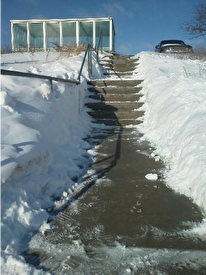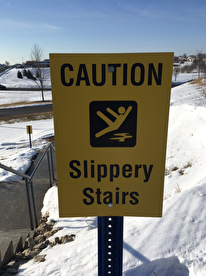
The Mayo Clinic in Rochester is a big place, especially for winter maintenance crews. Around 65,000 people visit the campus every day, with foot traffic 24 hours a day, seven days a week. The campus has 15 miles of sidewalk, 120 acres of parking lot, and 300 doorways, all of it in need of snow removal in the winter. Heavy salting has traditionally been the tool of choice, but environmental, infrastructure, and financial concerns have begun to cause maintenance crews to consider alternatives.
“Paved surfaces keep growing,” said Nick Queensland, grounds maintenance supervisor at the Mayo Clinic and a presenter at the Road Salt Symposium in October. “That is one of the things that kind of spurred our salt reduction efforts. If we just kept going the way things were going, the snow budget kept going up.”
Though the Mayo Clinic is a private entity, the process Queensland and his crew went through to reduce salt usage could be applied almost anywhere—private and public sectors both. It also wasn’t revolutionary or expensive, he said; it was mostly a matter of putting in the effort to plan carefully and communicate.
Pre-planning

Queensland knew he couldn’t simply jump in and cut Mayo Clinic’s salt usage without doing some initial planning. “From my experience,” he said, “if you’re going to make a big change, and the change is going to last, it’s got to be incremental. You’ve got to get buy in.”
For the first year, he spent his time simply observing the snow removal process at the clinic, noting how the contractors worked and where excessive salt was causing damage to the campus green spaces and infrastructure. During the 2017–2018 winter he started cutting back on salt, but he was more or less alone in the matter and found it difficult to change the practices of contractors halfway through the season.
As he researched the problem, Queensland happened across the Minnesota Pollution Control Agency’s Smart Salting training program, and this changed the situation significantly. His snow removal crews and leadership became Level 1 certified, and with everyone finally on the same page, “ideas were flying,” he said. They learned to coordinate contractors well in advance—as early as July—and started experimenting with alternatives to salt.
Practices

No single method proved effective on its own; salt reduction involved many little projects that had a big effect when taken together. In one instance, Queensland took note of a particularly nasty stretch of stairs where frequent foot traffic made it necessary to heavily salt. In response, Queensland set up a $20 sign that warned visitors of icy stairs.
“That paid for itself,” Queensland said. Accidents at that spot fell to zero that winter, and maintenance crews saved around $20 in salt per snow event.
Queensland and his crew experimented with brine, which proved effective at clearing roads, though not sidewalks. They also had their contractors calibrate their salt spreaders so that they put out salt at a consistent, calculated rate, and the crews began spot-salting rather than blanket-covering the entire campus.
Results
The results from Queensland’s efforts have been significant.
“Last year we were able to reduce our salt usage by 60 percent in one year,” he said. Mayo Clinic data monitoring falls on the campus showed no significant differences from the 2016–2017 to 2017–2018 winters. Queensland could not speak as to the exact dollar amount that the clinic saved on salt, but the money did come back to his crew and they were able to buy two new snow blades, a used pickup truck for their brine sprayer, and a new sidewalk machine.
“Nothing revolutionary, nothing expensive,” Queensland said. “It took effort.”
—Sophia Koch, LTAP freelancer